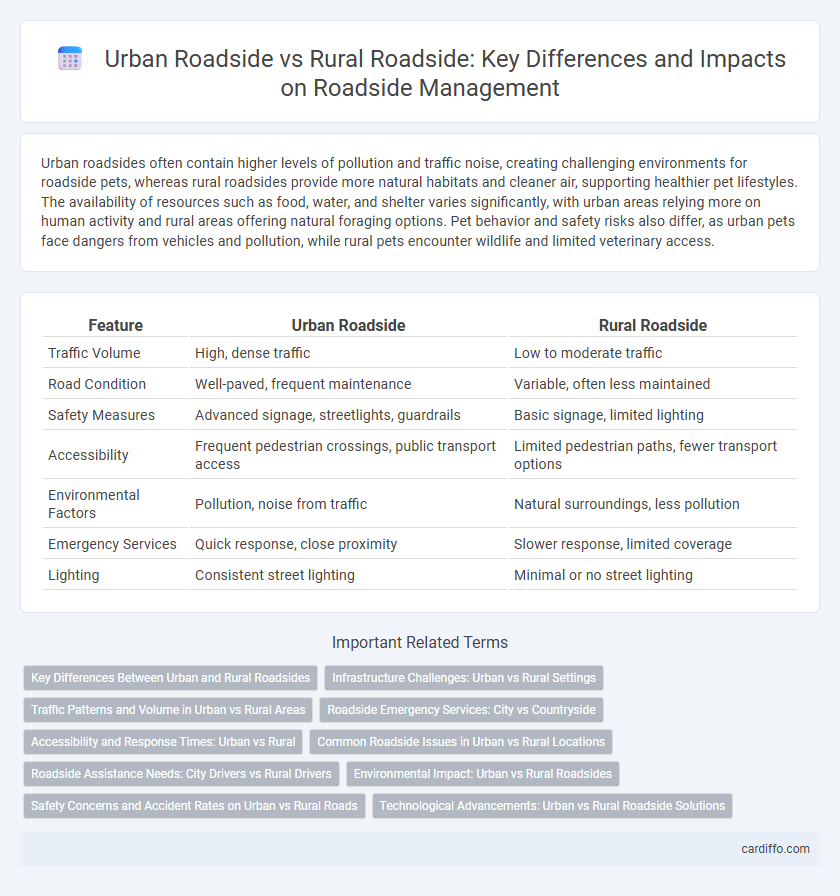Urban roadsides often contain higher levels of pollution and traffic noise, creating challenging environments for roadside pets, whereas rural roadsides provide more natural habitats and cleaner air, supporting healthier pet lifestyles. The availability of resources such as food, water, and shelter varies significantly, with urban areas relying more on human activity and rural areas offering natural foraging options. Pet behavior and safety risks also differ, as urban pets face dangers from vehicles and pollution, while rural pets encounter wildlife and limited veterinary access.
Table of Comparison
| Feature | Urban Roadside | Rural Roadside |
|---|---|---|
| Traffic Volume | High, dense traffic | Low to moderate traffic |
| Road Condition | Well-paved, frequent maintenance | Variable, often less maintained |
| Safety Measures | Advanced signage, streetlights, guardrails | Basic signage, limited lighting |
| Accessibility | Frequent pedestrian crossings, public transport access | Limited pedestrian paths, fewer transport options |
| Environmental Factors | Pollution, noise from traffic | Natural surroundings, less pollution |
| Emergency Services | Quick response, close proximity | Slower response, limited coverage |
| Lighting | Consistent street lighting | Minimal or no street lighting |
Key Differences Between Urban and Rural Roadsides
Urban roadsides typically feature dense infrastructure, including sidewalks, streetlights, and utility poles, designed to support high pedestrian and vehicle traffic. Rural roadsides often have wider shoulders, fewer artificial structures, and natural vegetation that provide habitats for wildlife and serve as runoff buffers. Safety measures differ significantly, with urban roadsides prioritizing pedestrian protection and rural roadsides emphasizing visibility and hazard avoidance.
Infrastructure Challenges: Urban vs Rural Settings
Urban roadside infrastructure faces challenges such as high traffic density, limited space for expansion, and the need for advanced drainage and lighting systems to handle heavy usage. Rural roadside infrastructure contends with issues like limited funding, lower population density reducing maintenance prioritization, and difficulties in implementing modern technology due to isolation. Both settings require tailored solutions to address unique spatial constraints and resource availability for effective road safety and functionality.
Traffic Patterns and Volume in Urban vs Rural Areas
Urban roadside environments experience significantly higher traffic volume due to dense population and multiple commuting routes, leading to frequent congestion and slower traffic flow. In contrast, rural roads typically have lower traffic volume with more consistent speeds and less congestion, though they may be affected by agricultural vehicles or seasonal fluctuations. Traffic patterns in urban areas show peak-hour surges linked to work commutes, while rural areas display more uniform traffic spread throughout the day.
Roadside Emergency Services: City vs Countryside
Urban roadside emergency services benefit from faster response times due to higher density of service stations and better infrastructure, ensuring quick assistance for vehicle breakdowns and accidents. In rural roadside areas, limited service coverage and longer travel distances often delay emergency response, increasing reliance on self-help and local resources. Enhanced GPS tracking and mobile network improvements aim to bridge the gap between city and countryside roadside support.
Accessibility and Response Times: Urban vs Rural
Urban roadsides typically offer greater accessibility due to denser infrastructure and nearby emergency services, resulting in faster response times. In contrast, rural roadsides often face challenges with limited access points and sparse emergency resources, causing delayed response and longer wait times. Efficient roadside assistance in urban areas benefits from advanced traffic management systems, while rural areas require strategic resource allocation to improve emergency response efficiency.
Common Roadside Issues in Urban vs Rural Locations
Urban roadside environments frequently face issues such as traffic congestion, limited parking spaces, and litter accumulation due to higher population density and commercial activity. Rural roadsides commonly experience problems like poor maintenance, inadequate signage, and vegetation overgrowth, which can impact road safety and visibility. Both urban and rural roadsides require targeted management approaches to address these distinct challenges effectively.
Roadside Assistance Needs: City Drivers vs Rural Drivers
Urban roadside assistance frequently addresses challenges like heavy traffic accidents, complex navigation, and frequent vehicle breakdowns due to stop-and-go conditions, demanding rapid response times and versatile service capabilities. Rural roadside assistance often involves longer wait times, limited service providers, and coverage for diverse terrains, where drivers encounter issues like tire punctures, fuel shortages, or engine troubles far from immediate help. Understanding these distinct needs helps optimize resource allocation and improve response efficiency for city drivers versus rural drivers.
Environmental Impact: Urban vs Rural Roadsides
Urban roadsides often exhibit higher levels of pollution due to increased vehicle emissions, dense infrastructure, and limited green space, impacting local air and soil quality. In contrast, rural roadsides typically support greater biodiversity and serve as crucial habitats for native flora and fauna, though they may experience agricultural runoff and pesticide exposure. Managing environmental impact requires tailored strategies addressing urban pollution challenges and conserving rural ecological balance along roadsides.
Safety Concerns and Accident Rates on Urban vs Rural Roads
Rural roads have higher accident rates and fatality risks due to higher speeds, limited lighting, and fewer safety barriers compared to urban roads. Urban roads experience more frequent collisions caused by heavy traffic, intersections, and pedestrian activity, yet benefit from better emergency response times and infrastructure safety measures. Safety improvements on rural roads, such as enhanced signage, lighting, and guardrails, are critical to reducing the disproportionate number of serious accidents relative to urban areas.
Technological Advancements: Urban vs Rural Roadside Solutions
Urban roadside solutions increasingly integrate smart technologies such as IoT sensors, real-time traffic monitoring, and adaptive lighting systems to enhance safety and reduce congestion. Rural roadside advancements prioritize durable, low-maintenance technologies like solar-powered lighting and satellite-based communication for effective monitoring despite limited infrastructure. These technological differences reflect contrasting priorities, with urban areas focusing on data-driven efficiency and rural areas emphasizing sustainability and connectivity under resource constraints.
Urban Roadside vs Rural Roadside Infographic

 cardiffo.com
cardiffo.com